Articles
- Page Path
- HOME > Korean J Community Nutr > Volume 21(1); 2016 > Article
-
Research Article
- Developing Food Safety Education Program for Employees at School Foodservice Implementing HACCP
-
Hye-Yeon Lee, Hyun-Joo Bae

-
Korean Journal of Community Nutrition 2016;21(1):84-92.
DOI: https://doi.org/10.5720/kjcn.2016.21.1.84
Published online: February 29, 2016
Department of Food and Nutrition, Daegu University, Gueongbuk, Korea.
- Corresponding author: Hyun-Joo Bae. Department of Food and Nutrition, Daegu University, 201 Daegudae-ro, Jillyangup, Gyeongsansi, Gyeongbuk, 38453, Korea. Tel: (053) 850-6835, Fax: (053) 850-6839, bhj@daegu.ac.kr
Copyright © 2016 The Korean Society of Community Nutrition
This is an Open-Access article distributed under the terms of the Creative Commons Attribution Non-Commercial License (http://creativecommons.org/licenses/by-nc/3.0/) which permits unrestricted non-commercial use, distribution, and reproduction in any medium, provided the original work is properly cited.
- 362 Views
- 2 Download
- 2 Crossref
Abstract
-
Objectives
- This study was performed to develop a food safety education program for school foodservice employees and evaluate its effectiveness.
-
Methods
- Food safety education programs were made into two levels; one for new employees in school foodservice and another for employees in charge of Critical Control Point (CCP) monitoring. The programs were for 40-minute-long lecture using PowerPoint. The effectiveness of these programs were assessed based on eleven evaluation items by school foodservice dieticians (n=30) and the Hazard Analysis Critical Control Point (HACCP) specialist (n=13). All statistical analyses are conducted by SPSS package program (ver 20.0).
-
Results
- According to the results of evaluating the food safety education program by dietitian and HACCP specialist, the overall satisfaction score was 4.14, evaluated by 5 point scale. There were no significant difference in results of evaluation between dieticians and HACCP specialists. The score of 'it is helpful to work' and 'pictures, images and charts are pertinent to study' were higher than others while the score of 'education contents is pleasant and interesting' and 'screen is pleasant and interesting' were the lowest among all evaluation items.
-
Conclusions
- To increase the school foodservice quality, employees should be offered regular food safety education and training through effective education media including prerequisite program and HACCP manual for school foodservice.
- 1. Ministry of Government Legislation. School foodservice operation law [Internet]. Ministry of Government Legislation; 2013; cited 2015 Dec 30]. Available from: http://www.moleg.go.kr.
- 2. Kim GM, Lee SY. Analysis of the school foodservice facilities and sanitary education -Seoul, Gyeonggi, Kangwon and Choongchung areas in Korea-. Korean J Community Nutr 2009; 14(5): 576-589.
- 3. Kim EJ, Choi JH, Kwak TK. Analysis of microbiological hazards to determine S. aureus contamination levels at school foodservice operation in Gyeonggi province. Korean J Food Cookery Sci 2009; 25(3): 365-378.
- 4. Kim YH, Lee YK. A survey of receiving management of school foodservice in Daegu and Gyeongbuk province. Korean J Food Preserv 2012; 19(4): 611-618.Article
- 5. Ministry of Food and Drug Safety. Foodborne poisoning statistics (2011~2015) [Internet]. Ministry of Food and Drug Safety; 2016; cited 2016 Jan 30]. Available from: http://www.foodsafetykorea.go.kr/portal/main.
- 6. Kim GM, Lee SY. A study on the sanitation management status and barriers to HACCP system implementation of school foodservice institutions in Seoul metropolitan area. Korean J Community Nutr 2008; 13(3): 405-417.
- 7. Hong WS, Yim JM, Choi YS. Sanitary performance and knowledge of elementary school foodservice employees in Seoul. J Korean Diet Assoc 2008; 14(4): 382-395.
- 8. Jeon EK, Bae HJ. Evaluation of sanitation management performance within school foodservice facilities and utilities in Gyeongbuk province. Korean J Food Cookery Sci 2009; 25(1): 62-73.
- 9. Chang HW, Bae HJ. Assessment of food sanitation knowledge and performance of foodservice workers in school foodservice operations implementing HACCP. Korean J Food Cookery Sci 2010; 26(6): 781-790.
- 10. Kim GM, Lee SY. Analysis of TQM-based HACCP system and safety management performance in middle and high school foodservice operations -Seoul, Gyeonggi, Incheon, Kangwon and Chungcheong areas in Korea-. J Korean Diet Assoc 2011; 17(1): 72-90.
- 11. Lee HY, Chang HW, Bae HJ. Importance-performance analysis about sanitation management items performed by school food service workers. Korean J Food Cookery Sci 2011; 27(1): 21-31.Article
- 12. Kwon SH, Lee HO, Chung DH, Shin WS, Om AS. The seasonal microbiological quality assessment for application of HACCP system to the elementary school foodservice. Korean J Soc Food Cookery Sci 2003; 19(5): 647-658.
- 13. Kim SA, Yi HC, Kim EM, Lee MA, Park JA, Kim JW. Assessment of microbial contamination levels of elementary school classrooms as foodservice environments. Korean J Food Cookery Sci 2007; 23(3): 321-326.
- 14. Seo HY, Jung BM. Comparison of foodservice management practices in the employee feeding operations of Jeonnam and Chungchong area. Korean J Community Nutr 2004; 9(2): 191-203.
- 15. Park SH, Lim YH. A study on the sanitary management of school foodservice operations in Daejeon and Chungnam. Korean J Community Nutr 2005; 10(2): 234-242.
- 16. Lee KE, Lee HS. Influences of school foodservice dietitians' job satisfaction and perception of barriers to HACCP implementation on food sanitation/safety management performance in Gyeongbuk province. J Korean Diet Assoc 2005; 11(2): 179-189.
- 17. Soh GS, Kim YS, Shin DH. A survey on the sanitary management in food service institutions. J Food Hyg Saf 2007; 22(1): 63-75.
- 18. Lee JH, Goh YK, Park KH, Ryu K. Assessment of food safety management performance for school foodservice in the Seoul area. Korean J Community Nutr 2007; 12(3): 310-321.
- 19. Kwak TK, Lee KM, Chang HJ, Kang YJ, Hong WS, Moon HK. Analysis of critical control points through field assessment of sanitation management practices in foodservice establishments. Korean J Food Cookery Sci 2005; 21(3): 290-300.
- 20. Kim YS, Jeon YS, Han JS. Inhibition effect of sanitizers against E. coli and a hygienic condition on the surface of utensils and equipments used to food service. J Korean Soc Food Sci Nutr 2002; 31(6): 965-970.Article
- 21. Kim JH, Kim YS, Han JS. Seasonal changes of microbiological counts and sanitation state on the surface of foodservice facilities and utilities. J Korean Soc Food Sci Nutr 2004; 33(10): 1653-1660.Article
- 22. Bae HJ, Lee HY. Importance evaluation about the remedies for improvement of sanitation management by foodservice managers. Korean J Community Nutr 2010; 15(2): 266-274.
- 23. Ministry of Education. Food safety manual for school foodservice establishment [Internet]. 2010; cited 2015 Dec 30]. Available from: http://www.moe.go.kr/main.do.
- 24. Lee HY. Verification of the HACCP system and developing remedies for improving foodservice quality at school foodservice establishments [dissertation]. Daegu University; 2014.
- 25. Lee HY, Yang IS, Kang YH, Kim HY. How can we develop and make use of the quality assessment tool of web-based instruction (WBI) for nutrition education? Korean J Nutr 2004; 37(4): 310-315.
- 26. Jung HA. The development of web-based education program for foodservice managers [dissertation]. Sookmyung Women's University; 2005.
- 27. Park YH, Kim HH, Shin EK, Jun SY, Lee YK. Development and evaluation of sanitation education media for restaurant employers and employees. J Korean Diet Assoc 2008; 14(2): 139-151.
- 28. Ahn HS, Ku BS, Lee SM. Systematic evaluation on the quantitative and qualitative aspects of Korean nutrition education websites. J Korean Diet Assoc 2008; 14(3): 218-228.
- 29. Yang HS, Han EH, Sohn HS, Rho JO. A study on the sanitary education program at school foodservice operations in Jeonju. J Korean Living Sci Assoc 2006; 9(3): 81-87.
- 30. Um YH. A study on actual sanitary management conditions and education plan of school foodservice employees. Korean J Culinary Res 2010; 16(3): 237-249.Article
- 31. Hong WS, Yim JM. Evaluation of foodservice employees' sanitary performance and sanitary education in middle and high schools in Seoul. J Korean Diet Assoc 2009; 15(2): 113-127.
- 32. Yoon JY, Moon HK. Perception of hygiene education and food safety knowledge among new restaurant owners -focused in Gyeongnam area-. J Korean Diet Assoc 2007; 13(3): 265-276.
- 33. Ministry of Food and Drug Safety. Educational materials for prevention of the foodborne outbreaks [Internet]. Ministry of Food and Drug Safety; 2014; cited 2015 Dec 30]. Available from: http://www.mfds.go.kr/fm/article/list.do?boardKey=22&menuKey=146.
- 34. Garayoa R, Vitas AI, Leturia MD, Jalon IG. Food safety and the contract catering companies: food handlers, facilities and HACCP evaluation. Food Control 2011; 22(12): 2006-2012.
- 35. Strohbehn CH, Gilmore SA, Sneed J. Food safety practices and HACCP implementation: perceptions of registered dietitians and dietary managers. J Am Diet Assoc 2004; 104(11): 1692-1699.PubMed
- 36. Bae HJ, Paik JE, Joo NM, Youn JY. HACCP principles and applications for foodservice manager. 1st ed. Paju: Kyomunsa; 2012. p. 236-252.
REFERENCES
Figure & Data
REFERENCES
Citations

- Perception on HACCP System of School Foodservices Dietitians in Chungbuk
Ji Hyeoun Im, Miao Miao Li, Young Eun Lee
Korean Journal of Food and Cookery Science.2019; 35(1): 57. CrossRef - Perception of Use of Environment-friendly Agricultural Products during School Foodservice of Mothers of Elementary School Students in Gyeonggi
Young-Un An, Myung-Hee Kim, Mi-Kyeong Choi, Mi-Hyun Kim
Korean Journal of Community Nutrition.2018; 23(3): 234. CrossRef
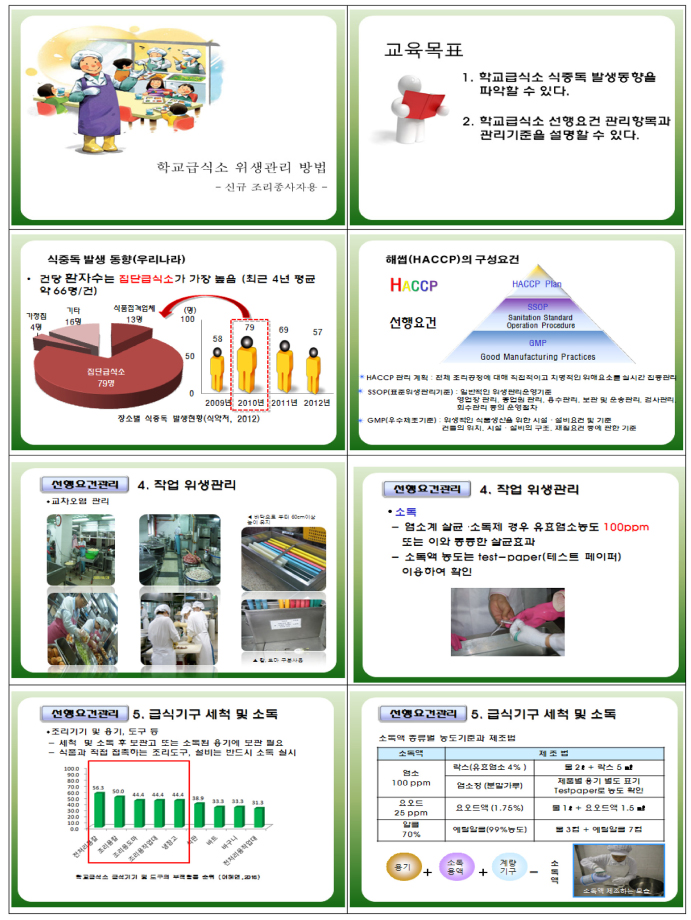
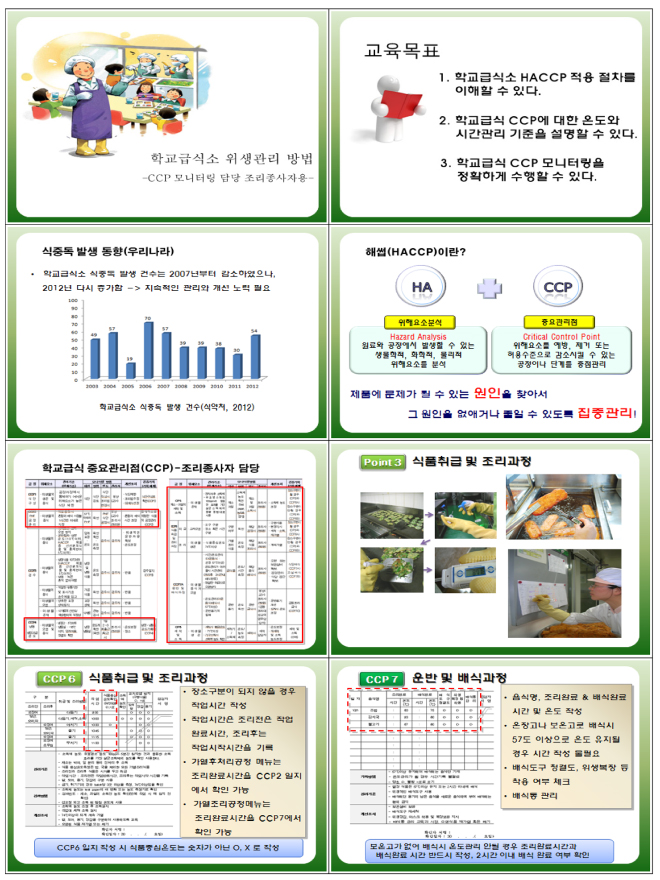
Fig. 1
Fig. 2
Sanitation education contents for school foodservice employees
Characteristics of the study subjects
1) Mean±SD
Comparison analysis of evaluating on sanitation education contents for foodservice employees between dietitians and HACCP specialists
1) Mean±SD: The scores were based on the mean scores measured on a Likert-type scale from 1 to 5 (1: Strongly disagree~3: neither~5: Strongly agree).
Correlation between evaluation score of each item and overall satisfaction
1) Pearson correlation coefficient
**: p < 0.01, ***: p < 0.001
1) Mean±SD
1) Mean±SD: The scores were based on the mean scores measured on a Likert-type scale from 1 to 5 (1: Strongly disagree~3: neither~5: Strongly agree).
1) Pearson correlation coefficient **: p < 0.01, ***: p < 0.001

 KSCN
KSCN


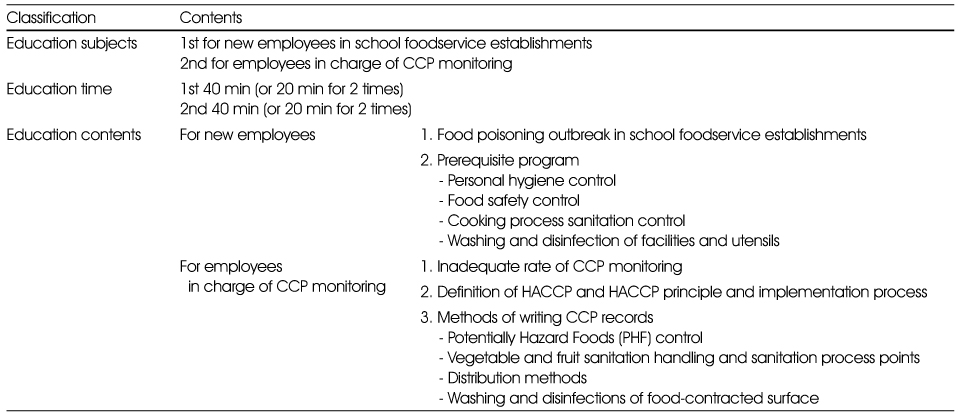
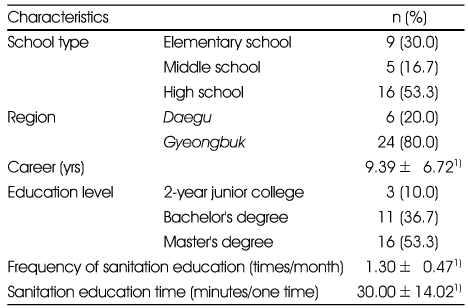
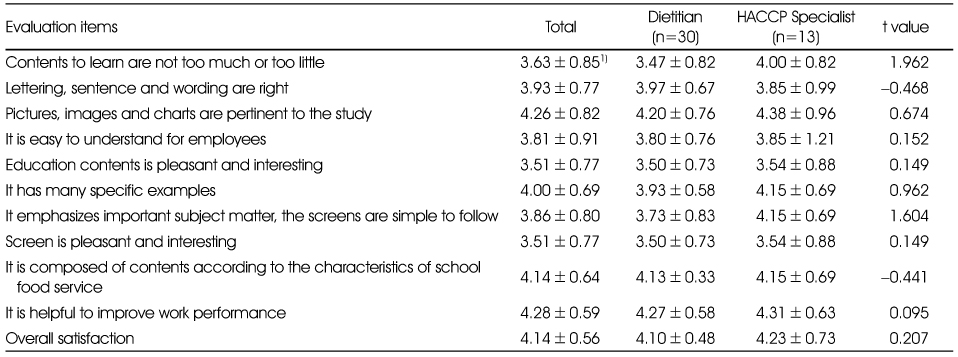
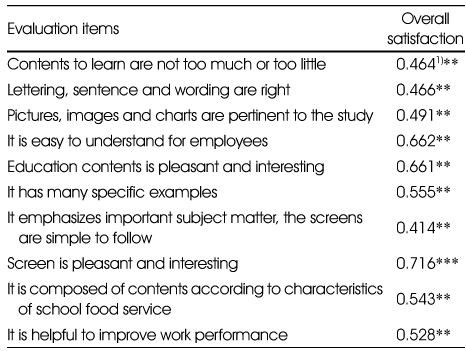
 PubReader
PubReader Cite
Cite


